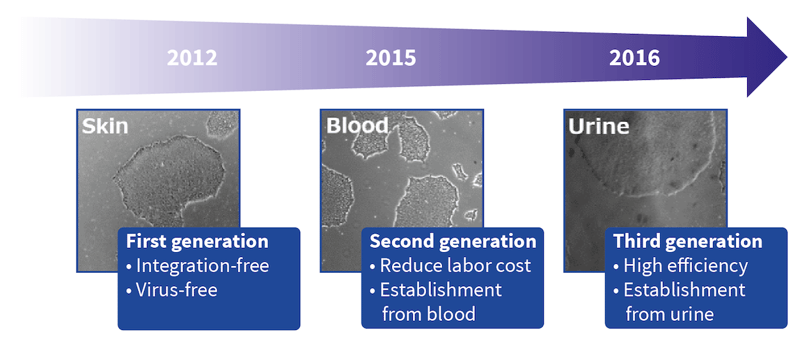Research Stem Cell Services
iPSC Reprogramming Service
At REPROCELL, you can gain access to the most rapid integration-free reprogramming method on the market: StemRNA™ 3rd Gen reprogramming technology. StemRNA™ is up to 50 times more efficient than any other non-integrative methodology on the market*, allowing you to access the highest quality iPSCs for your research. Our RNA technology has been used across a diverse range of iPSC projects in the research community, from enhancing in vivo research models[2] to optimising human iPSC reprogramming[3].
* Compared with Episomal reprogramming methodology Epi5 (0.03 - 0.04%), StemRNA™ 3rd generation is at least 50 times more efficient (2.00 - 4.00%).
The Benefits of RNA Reprogramming
StemRNA™ is the ideal vector for introducing reprogramming factors into cells, because RNA is:
- Footprint-Free — mRNA vectors are rapidly degraded 48 hours following transfection, meaning there is no need to screen your iPSCs for vector retention
- Integration-free — No DNA is used during reprogramming, eliminating the risk of genomic integration of reprogramming factors or vector sequences[1]
- Efficient — RNA reprogramming is highly efficient, requiring fewer starting target cells than other methods – increasing the likelihood of success with difficult to reprogram cells[4]
- Rapid — RNA reprogramming provides rapid access to iPSC colonies and useable iPSCs for projects where timing is critical
RNA reprogramming is the optimal method for iPSC establishment[1],[2] and our latest generation technology can be used to transform samples from skin, blood and urine. StemRNA™ uses RNA transgenes, rather than DNA or viral vectors, which is rapidly degraded by cells. The resultant iPSCs therefore possess low transgene persistence, increased chromosomal stability and reduced clonal variation[4]. As RNA reprogramming leads to decreased copy number variation (CNV), it also reduces the risk of oncogenesis and abnormal karyology[1].
The Evolution of StemRNA™
At REPROCELL, our dedicated R&D team are always looking for ways to improve our services. For example, since the introduction of our reprogramming technology in 2012, we have increased the number of sources your RNA-iPSCs can be derived from and have extended our human tissue network to allow rapid access to patient samples (Figure 2).

Figure 2. The evolution of StemRNA™ 3rd Gen Reprograming Technology.
Flexible, Customized Reprogramming
Whether you have your own cells that require reprogramming or wish to source tissues from a select patient group, our expert scientists have the resources and expertise to achieve your research goals. Although typical clinical samples used for REPROCELL reprogramming services are human blood or urine, other options may be possible including alternative species and tissues or cell-lines. You can find out more from our custom iPSC services FAQ or from our blog.
Resources
- FAQ – Custom iPSC Services
- Brochure: Stem Cell Research Services
- Review Article: The Past, Present and Future of iPSC Establishment
References
1. Schlaeger et al. A comparison of non-integrating reprogramming methods. Nature Biotechnology 33:1 (2015).
2. Nakajima et al. Establishment of induced pluripotent stem cells from common marmoset fibroblasts by RNA-based reprogramming. Biochemical and Biophysical Research Communications.In Press (2019).
3. Gagliano et al. Microfluidic reprogramming to pluripotency of human somatic cells. Nature Protocols 14 (2019).
4. Paull et al. Automated, high-throughput derivation, characterization and differentiation of induced pluripotent stem cells. Nature Methods 12:9 (2015).
5. Warren et al. Highly Efficient Reprogramming to Pluripotency and Directed Differentiation of Human Cells with Synthetic Modified mRNA. Cell Stem Cell 7:618 (2010).
6. Yakubov et al. Reprogramming of Human Fibroblasts to Pluripotent Stem Cells using mRNA of Four Transcription Factors. Biochemical Biophysical Research Communication. 394:189 (2010).


